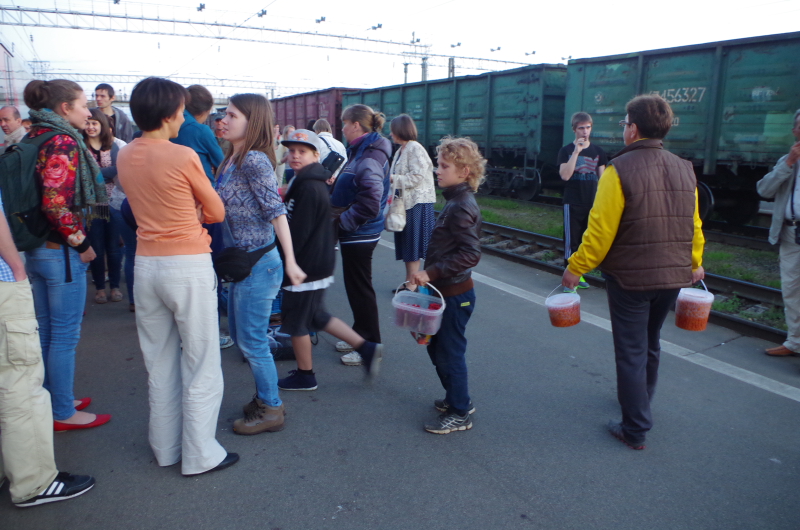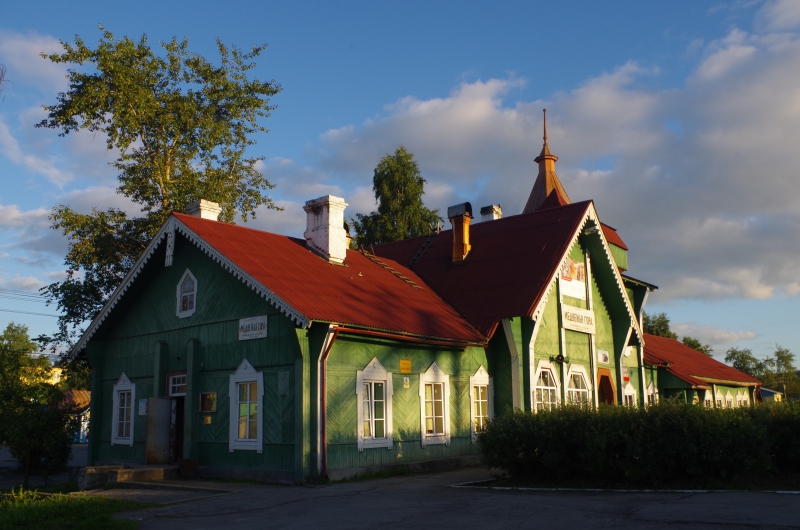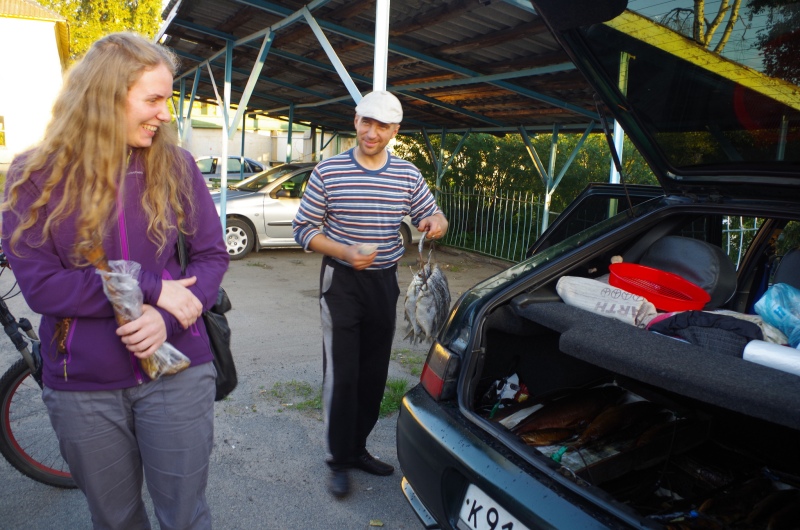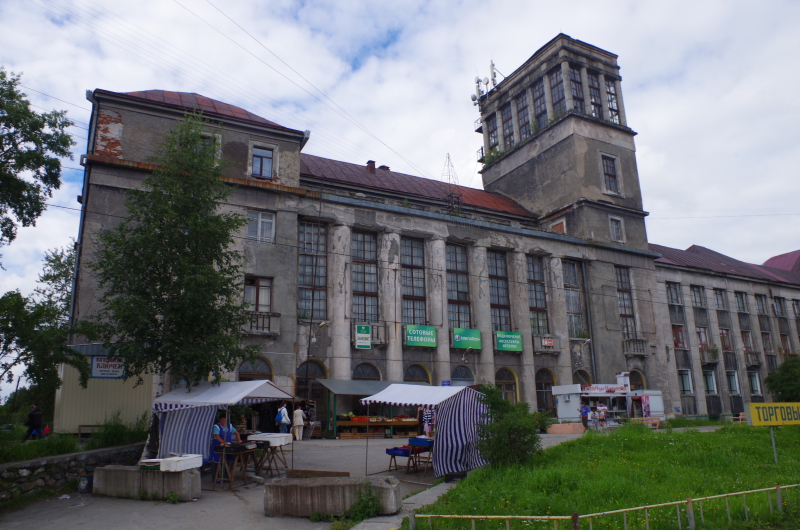
When most people think of Russian railroads, they think of the Trans-Siberian Railway. The world’s longest railroad extends east and west across the infinite Siberian tundra. But there is another set of railroads in Russia, and those are the ones that extend from north to south.
The Kirov Railway is one such vital line that links St. Petersburg with Murmansk, Russia’s only ice-free port on the Arctic. The railroad was built between 1914 and 1959, and was electrified in 2005. This past August, with the Field Experiences in Northwest Russia (FENOR) Summer Field School, I took the train from Ladozhsky station in St. Petersburg to Petrozavodsk, the capital of the Republic of Karelia 430 kilometers to the northwest.
We arrived at the modest station in the eastern part of Russia’s former imperial capital about an hour before the departure. To kill time, I decided between which of the four little espresso vending machines to use. Russia is a country that loves its instant coffee, and it is never hard to find. For 30 rubles (about 50 cents), I purchased a frothy plastic cup full of caffeinated chemicals. I sipped on this while I watched the politsiya (policemen) and Chinese tourists milling around.
After about an hour of sticking my head into the little train station shops selling beer, sushki (flavorless dried bread rings), and Orthodox icons, we headed down to our platform. I half expected, or rather even hoped, to see a derelict steam engine, something straight out of Anna Karenina. But that was not to be. Instead, the train that was waiting for us was shiny and red, putting the trains in the U.S. to shame. Our group of students stood slumped under our huge backpacks while the conductor verified all of our passports before boarding.
On the dot, our train departed. There was no chug-chug of the train, just the smooth whir of modern wheels on steel. It was a Sunday night, and the train seemed to be packed with people going home after a weekend in the Northern capital. We settled into our much-too comfortable seats and gazed out the windows. This being August at 60°N, darkness was still far off in the distance.
Thirty minutes into our journey, some of the students started getting restless. A few decided to pop open their big plastic bottles of beer and start snacking on sushki. The custom of sharing snacks and drinks on Russian trains is as old as the railway system itself. But even this tradition is changing, for no sooner did people start sipping on their bottles of Baltika than the politsiya came thudding down the aisle. Drinking, as we abruptly found out, is no longer allowed on Russian trains. All of the students managed to hide their bottles in time, but two of the professors in our group were caught red-handed and had to confiscate them.
The train plugged northward past a landscape of dams, rivers, and birch forests. At the town of Svir, we stopped for ten minutes. A few of the Russians in our group bolted off the train to haggle with the merchants who had come to sell the bounties of the Republic of Karelia to train passengers. They stood quietly over their baskets full of black smoked fish and buckets spilling over with golden cloudberries and juicy blackberries. The reservedness of the impromptu market starkly contrasted with my past experiences of rolling up to train platforms in places like Thailand or Burma, where vendors run up to the train excitedly and holler out the prices of water bottles, coconut buns, and noodle soup through the windows. Alas, the windows on our thoroughly modern Russia train did not even open to the outside world.


We jumped back up onto the train a few smoked fish the richer. Drinking a beer now offends Russian law, but prying open a smoked fish with a small knife on top of the train table is still completely acceptable public behavior. The smell of lakes, smoke, fish, and forests permeated the train, causing many of our fellow Russian passengers to eye our table. Food envy is a universal trait. We passed around small pieces of white fish flesh in between a few more discreet sips of beer.

At one point, I walked through the train to find the lavatory. One wagon was full of the Chinese passengers I had seen in the Ladozhsky train station. China is the biggest sender of tourists to Russia (ahead of even Germany now), many of whom come to see the Hermitage in St. Petersburg and then continue northward to explore Arctic landscapes.
Night came eventually around 10:30 pm. At 10:55 pm, about five hours after setting off from St. Petersburg, we arrived at our destination: Petrozavodsk. The Karelian capital has 267,000 people – about the size of Lincoln, Nebraska – but it has an impressive train station like many towns and cities across Russia. Desire for railways – the emblem of modernity – dates back to the Imperial Russian era, when construction on the Trans-Siberian Railway began in 1861. Daniel Brower writes, “By the 1860s business interests in Russia’s trading towns spoke of the railroad as an instrument of salvation. The extensive canal-and-river system remained hostage to the forces of nature, but access to rail lines meant freedom from these constraints and for the towns located away from the waterways a chance at last to compete in national and even international markets” (1990: 42).
Shopping at the railway station
Petrozavodsk marked the end of our rail journey in Northwest Russia, as we didn’t continue on to Murmansk. However, we would still have one more experience with the railway system.
The next morning, we departed Petrozavodsk by bus for the Karelian village of Kinerma. After spending one rustic night there in a home without running water, we made our way by bus to Medvezhyegorsk, which also lies on the Kirov Railway. The city sits astride the mirror-like Lake Onega, the second biggest lake in all of Europe. The sandy beach and late sunsets made it the perfect place to have campfires. Fires also help keep mosquitos away, which are an enormous pest in the swampy Republic of Karelia. One Russian expressed surprise at how pleasant the beach was: “In most of Russia, these types of places would be dirty and full of trash,” she said. I also learned that in Russia, it’s not a proper campfire without smoked fish and berries. Where to buy these necessities? At the train station, naturally.
So on our second day in Medvezhyegorsk, five of us made our way to the train station, about a 20 minute walk from our unapologetically Soviet hotel (read: coffee with condensed milk served out of cans, vinegary potato salad thrown down onto the table, and a facade that only Kruschev could love). We tried to time our walk so that we would meet the incoming train from St. Petersburg. When we got there, however, there was not a person nor a train in sight. A couple of politisiya ambled about, and I naively took a couple of photographs of the charming train station before my Russian friend warned me that photographing sites of critical infrastructure, like this obviously geostrategically crucial train station in the middle of nowhere, was illegal. The policemen didn’t do anything, though, besides shoot me a few suspect glances.

My Austrian colleague and I lost faith in the idea of obtaining a tasty, fishy snack that evening. But we had forgotten that in Russia, everything is somehow simultaneously possible and impossible. Our Russian friend marched into the empty train station and had a few words with the attendant. “Someone is coming,” she smiled as she walked out. I was confused for all of two minutes until a beat-up black car came screeching out of a dusty alley, followed by two curious teenage boys on bicycles. A man in a tight-white t-shirt jumped out of his car. Had this been inner city Los Angeles, I might have half expected drugs to be stashed in the trunk. Instead, there were palettes upon palettes of smoked fish of all different types and qualities. Our Russian colleague chose the best couple of fish and handed over a few hundred rubles while I snapped some photographs. “What about the berries?” I asked. (The Russian word for berries, yagodi, sounds like what you might call small Yoda-like creatures from the swampy planet of Dagobah in Star Wars). “Aha!” The man responded. He skipped back over to the backseat of his car and pulled out several empty milk jugs that had been refilled with berries. “I’ll take one bottle,” I said, handing over my quickly depreciating rubles.


The miracle of the whole situation was that the formal and informal infrastructure of the Russian railway system, from the politsiya to the station attendant to the fish-and-berry man waiting to make a few quick rubles, still functioned even without the train. Everything was in place to spring into action if the train arrived – but that was a big if. Medvezhyegorsk, like many Russian cities, has years of experience with waiting in anticipation. Not far from the center of town is an enormous crumbling structure, reportedly an old hotel that was built in anticipation of Stalin’s visit. Stalin never came, but the hotel is still there. Now, a vendor from Armenia sells some fruit from the Caucasus outside, while a Russian lady sells fish. Inside is a cell phone shop, a toy shop, and not much else. The story about Stalin’s visit may be apocryphal, but regardless, the hotel represents a category of infrastructure common in Russia, especially the Russian North. It is infrastructure built for a future that has not and may never arrive.




Excellent, descriptive story. I really enjoy your writing. Thank you.
Thanks, Lorene!